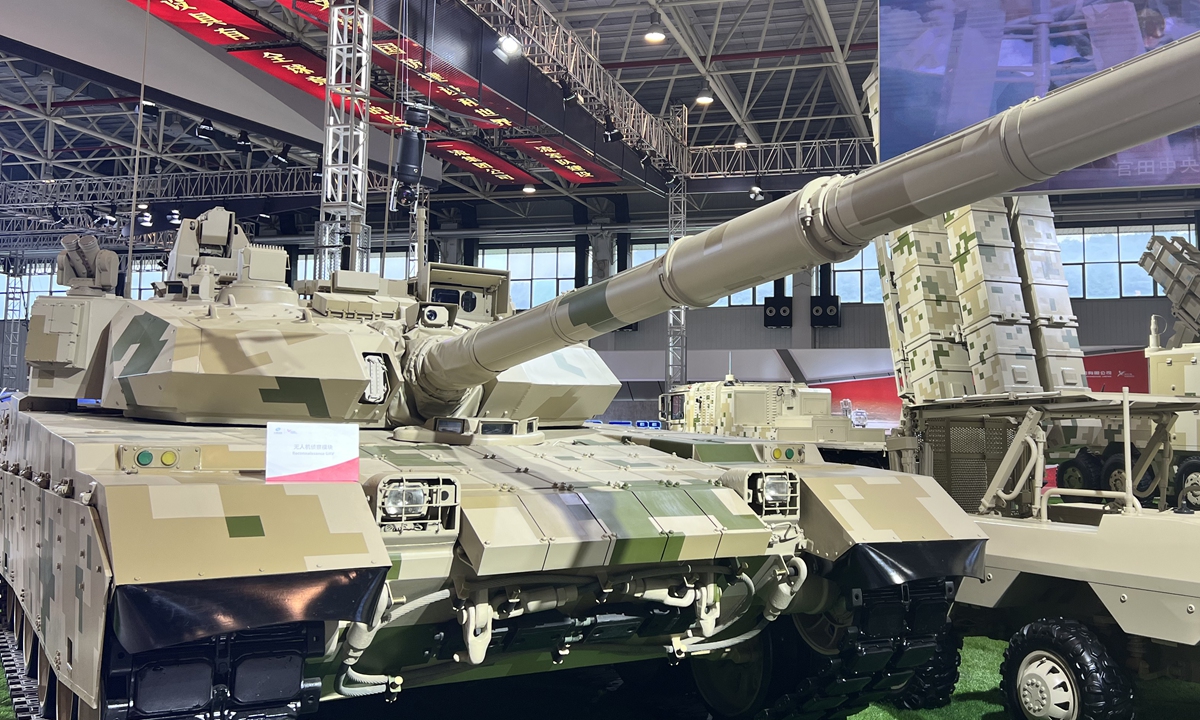
The VT-4A1 type main battle tanks is exhibited for the first time at the Airshow China. Photo: Cao Siqi/GT
China's leading arms producer exhibited its new-generation army brigade combat team for the first time at this year's Airshow China, which kicked off on Tuesday in Zhuhai, South China's Guangdong Province, reflecting the latest achievements of the integrated development of mechanization, information technology and intelligence of the Chinese army, and the concepts of manned-unmanned coordination and air-ground coordination.
The Global Times learned from NORINCO that the army brigade combat team covers combat support battalions, reconnaissance battalions, tank battalions, aircraft battalions, artillery battalions, anti-tank battalions, air defense battalions and UAV battalions.
As the combat experience of the conflict between Russia and Ukraine proves that the acquisition of battlefield intelligence is very important, Cheng Ziheng, an expert from NORINCO, told the Global Times that "the reconnaissance battalion is equipped with a complete intelligence-gathering system covering air and land."
"For example, the multi-functional ground reconnaissance vehicle is equipped with radar and electro-optical equipment, which can provide a comprehensive battlefield situation reconnaissance capability at a range of 10-20 kilometers."
The multifunctional UAV system can fly 100 kilometers and provide battle-level intelligence, while remote-sensing satellites can provide intelligence information within a radius of hundreds of kilometers through vehicle-mounted satellite communication systems, Cheng said.
"Reconnaissance battalions can provide accurate and real-time intelligence information to clear the fog of war," the expert said.
The tank battalion plays the role of "fortress," so that the army brigade combat team can achieve the effect of "walking, resisting and fighting steadily." The corporation displayed the VT-4A1 type main battle tanks for the first time at the Airshow. The model has been upgraded from the VT-4, a main battle tank that enjoys a high reputation at home and abroad. By upgrading the active protection system and the vehicle drones' situational awareness system, it can also perform coordinated combat with small unmanned vehicles.
Cheng said heavy assault forces, represented by tanks and armored vehicles, will still be the main force in the future frontal battlefield, but they will need to undergo information and intelligent transformation and strengthen battlefield situational awareness to adapt to new challenges.
To cope with the threat of advanced over-the-top attack munitions, the VT-4A1 is equipped with a high-precision millimeter-wave radar around the turret, which can detect incoming missiles and guide the active protection system to detonate incoming missiles from opponents, improving the tank's protection capability.
The VT-5U light tank in the tank battalion is also an unmanned transformation on the basis of the previous VT-5 light tank. It is equipped with a vehicle-mounted UAV, which can take off from the tank independently, ensuring the tank's aerial vision and enhancing its battlefield situational awareness.
The VT-5U also has the capability of "manned-unmanned conversion," which means that in high-risk combat situations, VT-5U crews can get out of the vehicle if necessary and fight with a remotely controlled tank, turning the king of land warfare into an unmanned combat vehicle.
Cheng revealed that the next development direction of China's main battle tank, in addition to improving the three traditional performance indicators of mobility, protection and firepower, will focus on enhancing situational awareness and information capabilities.
Also making its debut was the VN-20 tracked heavy infantry fighting vehicle. It has the same power cabin as the VT-4, but it is bulkier than the VT-4Al.
"It is because the VN-20 adds anti-mine components and more reactive armor around the hull of the VN-20, so that it has a strong protection level to maximize the safety of the infantry in the vehicle," Cheng said, noting that the current VN-20 protection capability has reached the world's advanced level.
In the conflict between Russia and Ukraine, the Russian army used large-caliber artillery bombardment and the Ukrainian army carried out "guerrilla artillery warfare" with the help of self-propelled howitzers provided by the West, which all show that artillery is still the "king of war" in modern large-scale ground combat, which determines the outcome of the battlefield.
Cheng said the artillery battalion's role was to deliver fire power. "Tanks and armored vehicles are mainly engaged in head-to-head confrontation, but to strike an opponent's effective force, it still needs artillery battalions to achieve it."
The artillery battalion is mainly composed of 155mm howitzers and long-range rocket launchers, which offer range integration, point-to-point combination, multiple damage and precision strikes.
The former includes traditional towed howitzers, the wheeled guns that can travel at high speeds in flat areas, and tracked self-propelled howitzers that can cross field environments such as flat ground. The corresponding combat equipment can be selected according to the needs of users in different combat environments.
A drone battalion also appeared in the army brigade combat team for the first time, which Cheng said showed that the rapid development of drone technology and equipment has enabled various types of drones to play important roles in certain situations.
The army brigade combat team is a new system model that all military powers in the world are focusing on. Providing such a solution shows China's ability to construct systemic equipment, to develop military communications technology, to instruct information for joint operations and to integrate multi-equipment modular systems, the expert stressed.




